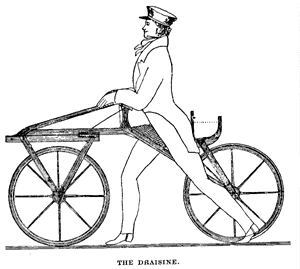I can't think of any technological advancement more simple, elegant, and useful than the bicycle. With all of the bicycle-related-events going on this summer abroad and here in San Francisco, including a film series here at the Main Library, it's nice to see that people aren't taking the two-wheeler for granted after well over a century of popular use. This led me to wonder where the bicycle came from.
The history of technology is dotted with examples of spontaneous inventions, of people plucking inspiration from the sky and inventing something entirely new. In 1849, when New Yorker Walter Hunt needed $15 to repay a debt to a friend, he took a length of wire, invented the safety pin, and sold the rights for $400.
That doesn't happen very often. Like most lasting innovations, the development of bicycles involved a series of gradual improvements upon previous designs. The earliest vehicle that a modern person might recognize as a precursor to the bicycle is Karl von Drais' draisienne. This early 19th century two-wheeler looks remarkably close to a modern bicycle, especially considering some of the stylistic diversions later two-wheelers would take. Have a look:
Not bad for a first try, right? There are, however, a couple of things about this design that prevented it from starting a transportation revolution; most notably, perhaps, is the lack of pedals or a chain. The vehicle is propelled using Flintstone-era drive train technology.
In the 1860's, the solution to the problem of locomotion began to pop up in France in the form of pedals. At first, pedals were attached directly to the bicycle's wheel, like you see in the patent drawing below, from Pierre Lallement's 1866 "Improvement in Velocipedes:"
This design (the French called it a velocipede) represents a major step forward, but attaching the pedals directly to the front wheel meant that the bicycle was still going to be, well, rather slow. If you ever rode one of those little red tricycles as a kid, then you're familiar with this configuration -- for every turn of the pedal, you get one turn of the wheel. That means that for each stroke, the vehicle only moves the length of the circumference of the wheel, which is really tiny in the case of a little red tricycle and still small enough to inhibit fast cycling in the early velocipedes.
Although the chain transmission was around by the 1870's, the prevailing solution to the problem of the 1:1 pedal to wheel revolution ratio was to make bigger wheels which traveled a greater distance for each revolution. Thus, the "penny-farthing:" The big-wheel solution proved temporary as the metallurgical technology would catch up within the next couple of decades to enable chains and steering mechanisms, both of which pretty closely resemble the components of a modern bicycle.
The big-wheel solution proved temporary as the metallurgical technology would catch up within the next couple of decades to enable chains and steering mechanisms, both of which pretty closely resemble the components of a modern bicycle.
There was, however, one missing component that prevented the bicycle from transcending the status of amusement device to become a revolutionary means of transportation -- a comfortable ride. Early bicycles were called "bone-shakers," which gives you an idea of how people felt about riding on either solid wheels or wheels with solid rubber tires over dirt and cobblestone roads. A Scottish man named John Dunlop (last name bring anything to mind?) figured out that if he equipped his son's tricycle, the kid wouldn't get headaches from the bumpy ride. He patented pneumatic tires in 1888, and shortly began to manufacture modern tires with inner tubes. And the rest is history.
The development is a testament to the collaborative nature of technological advancement, the idea that we arrive at groundbreaking technologies like the bicycle by building on the advancements of others. There is no one bicycle patent; the bicycles that carry people to work and play are the result of hundreds of patents for gears, inner tubes, levers, ball bearings, and every other component.
We've got a pretty nice collection of books about the history of inventions, including fun titles by Umberto Eco and Tom Philbin that proved very helpful in writing this post.
Sunday, July 27, 2008
"My invention consists in the arrangement of two wheels, the one directly in front of the other..."
Subscribe to:
Post Comments (Atom)


No comments:
Post a Comment